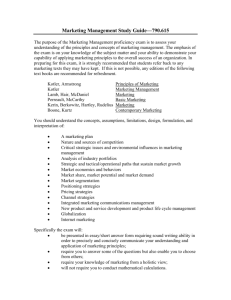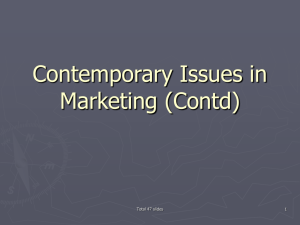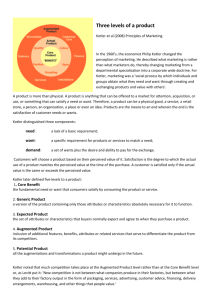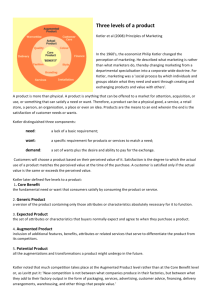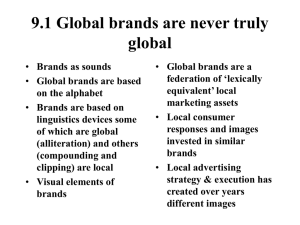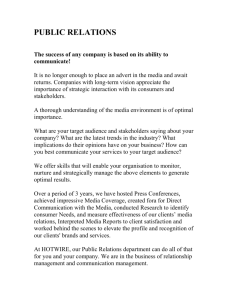MANDATORY DECISION: THE INTERNAL MARKETING STRATEGY
advertisement
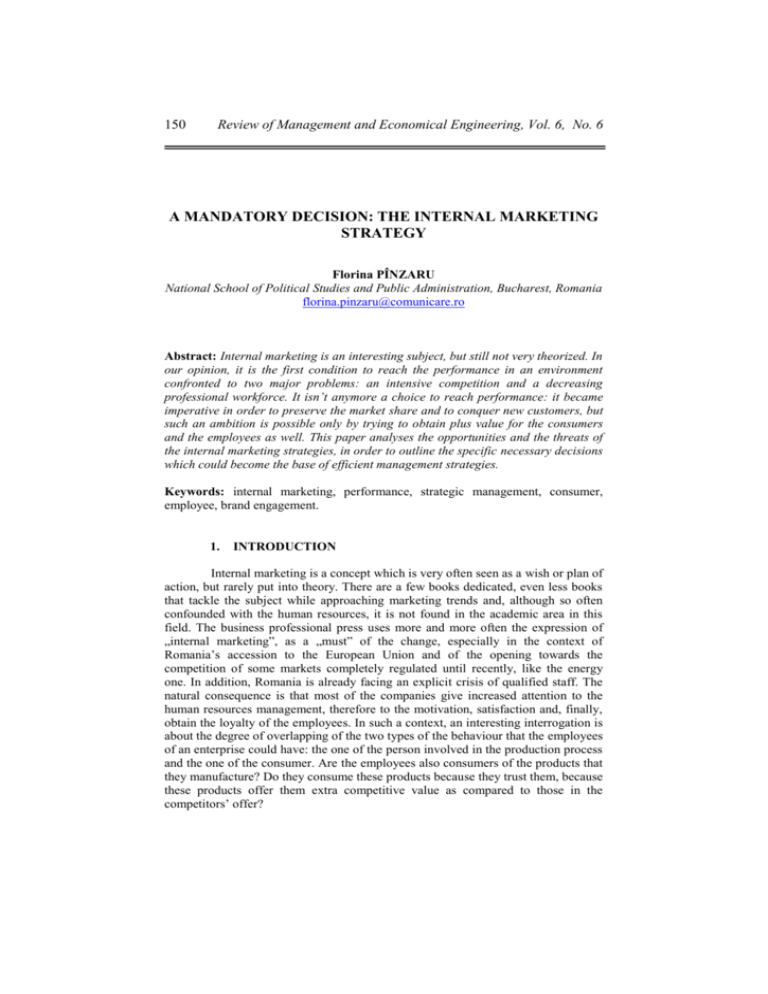
150 Review of Management and Economical Engineering, Vol. 6, No. 6 A MANDATORY DECISION: THE INTERNAL MARKETING STRATEGY Florina PÎNZARU National School of Political Studies and Public Administration, Bucharest, Romania florina.pinzaru@comunicare.ro Abstract: Internal marketing is an interesting subject, but still not very theorized. In our opinion, it is the first condition to reach the performance in an environment confronted to two major problems: an intensive competition and a decreasing professional workforce. It isn’t anymore a choice to reach performance: it became imperative in order to preserve the market share and to conquer new customers, but such an ambition is possible only by trying to obtain plus value for the consumers and the employees as well. This paper analyses the opportunities and the threats of the internal marketing strategies, in order to outline the specific necessary decisions which could become the base of efficient management strategies. Keywords: internal marketing, performance, strategic management, consumer, employee, brand engagement. 1. INTRODUCTION Internal marketing is a concept which is very often seen as a wish or plan of action, but rarely put into theory. There are a few books dedicated, even less books that tackle the subject while approaching marketing trends and, although so often confounded with the human resources, it is not found in the academic area in this field. The business professional press uses more and more often the expression of „internal marketing”, as a „must” of the change, especially in the context of Romania’s accession to the European Union and of the opening towards the competition of some markets completely regulated until recently, like the energy one. In addition, Romania is already facing an explicit crisis of qualified staff. The natural consequence is that most of the companies give increased attention to the human resources management, therefore to the motivation, satisfaction and, finally, obtain the loyalty of the employees. In such a context, an interesting interrogation is about the degree of overlapping of the two types of the behaviour that the employees of an enterprise could have: the one of the person involved in the production process and the one of the consumer. Are the employees also consumers of the products that they manufacture? Do they consume these products because they trust them, because these products offer them extra competitive value as compared to those in the competitors’ offer? International Conference on Business Excellence 2007 2. 151 MARKETING ORIENTED COMPANIES The idea of „marketing management” is not new and is already embraced by many organizations. The marketing-oriented organizations integrate the marketing activity with the other activities, by re-drawing structures and by developing internal processes and relations correlated in order to obtain value for the consumers. In many organizations, there are major communication barriers between marketing and other departments that trigger misunderstandings and conflicts (Cravens and Piercy, 2003, p. 477). For instance, the information collected and analysed by the marketing department is not correct or it is insufficiently used by the R&D department, following the competition for internal power between the two units. Similarly, there are more and more conflicts between marketing and sales, following two big sources of friction: economic – the division of the commercial budget and cultural – the analytical orientation of marketers vs. relationship orientation of sales people (Kotler, Rackham et al, 2006, p. 71). Therefore, marketers must prove superior coordination and integration skills in their activities of other functional areas existing within the organization. The companies’ movement towards processes makes this aspect become imperative and we include here examples such as the planning of new products, coordination of distribution channels, price analyses or strategic marketing alliances. The integration of the marketing ideas at the level of the entire organization is specific to the strategic marketing, correlating business strategies with the marketing ones at the managerial level. The organizational „drawing” must be evaluated regularly, to identify the degree of compatibility and to notice possible necessary changes. The upgrading and reengineering of many organizations in the 90’s led to modifications in the structures of the marketing units. In other words, for more than a decade, we have been assisting a continuous redesign of structures and processes in the purpose of efficient support of the marketing activity, both at the level of the profile department, and of the rest of the organization. After a long period of market oriented decisions, the marketing has started to be interiororiented, without understanding, by this, only the manner through which internal functional support is provided. 3. WHAT IS INTERNAL MARKETING? Internal marketing has been, for a long time, confounded with the internal communication. Nevertheless, there are many ways to understand this concept. The need of internal marketing appeared following the observation of the fact that the marketing strategy was, many times, short-cut inside the organization, with an effect on the exterior clients, but not on their own employees, consumers as well (sometimes without wanting to be customers of their own company). Thus, many organizations fall in the trap of believing that their employees will buy and use the products and services they offer, without asking questions, being loyal to them through the fact that they participate in creating those products. However, the reality is different. As a matter of fact, there are multiple possible definitions of the internal marketing. For example, internal marketing can be defined as „the philosophy to treat employees as consumers, upon product – job strategies satisfying the human 152 Review of Management and Economical Engineering, Vol. 6, No. 6 needs” (Cahill, 1996, p. 3). In this conception, internal marketing sells the function product, and the employees are the buyers. There are authors who relate the internal marketing idea to the management of the knowledge and learning and of the emergence of the knowledge-oriented employees (Ahmed and Rafiq, 2002). In such a vision, internal marketing becomes a key instrument for the effective achievement of the transformation of the organizational needs into individual challenges for the employees. By treating employees as clients, learning and any other objectives of the organization are presented in term of costs-benefits. The employees may increase the personal effectiveness if they transform their own knowledge into natural elements of the success of the organization, and internal marketing is a useful instrument in this sense. Thus, if the internal marketing helps to bring brilliant ideas, at the adequate moment, to the adequate people, it supports the management of knowledge and learning. There are also larger definitions of the internal marketing concept. For instance, the internal marketing could be understood as „a continuous process, through which the organization aligns, motivates and empowers the employees in all the functions and at all the levels to provide consistent and positive experience to the consumer, helping to fulfil the business objectives” (Williams and Curtis, 2006, p. 135). Thus, the internal marketing base consists in the relation existing between the organization and its employees, and one of the fundamental conditions of the success of marketing plans consists in treating employees as if they were external consumers. If the marketing creates brands for the customers, it should support the same brands also in the companies’ interior. It is what we call “brand engagement”, making employees really believe in the brands of their organizations. Internal marketing can no longer be seen as corollary or even opposed to the external marketing. If we proceed from the marketing definition, as „not a battle of the products per se, but a battle between the perceptions of the consumers on the products” (Ries and Trout, 2004, p. 30), internal marketing cannot be but integrated with the external one, in what we call, in brief, „marketing”. At present, „the customer” represents a generic concept: the first consumer of the products is the employee of the producing company. That’s why we can say that the first product of the company is its own message. Before being sold, the product communicates to those around it. The first people to hear the message of the product are the company’s employees. They should be responsible for transmitting the promise of the brand, and to guarantee of this promise before the consumers. Therefore, their behaviour, dressing style, tone of voice and other details related to them must comply with the values expressed by the brand. To syntheses, we can define three big manners to understand the concept of internal marketing: the policy of the quality of the internal service: treating the employees as consumers; the development of the internal notoriety of products or brands; the creation of internal relations of the type client – provider. 4. DO COMPANIES NEED INTERNAL MARKETING? The term of „performance” started to be used in management not only on the leading level, but also in the direct communication with its employees and clients, together with the increase in importance of sharing the organizational vision and mission, for a better achievement of the strategic objectives, under the International Conference on Business Excellence 2007 153 conditions of a greater competition. Moreover, the focus was placed, especially in the 90’s, together with the explosion of the idea of quality, to what we call, at present, „performance-oriented management” (Stifler, 2006). The concept of „performance management” has been existing since 1976, being used for the first time by Beer and Ruth, and it means, most often, „strategic and integrate process providing success to the organizations by improving people working within them and through development of the individual and team capacities” (Armstrong, 2000, p. 1). Practically, all the healthy organizations operating in competition markets are already aware that they must think in terms of performance, but, most of the times, they don’t. The greatest danger is to believe one is performant, without really being so. Therefore, the first element of the performance management, and the most important one, is to create the general strategic picture, including the idea of „performance” in the organization’s DNA, namely in its shared culture, therefore in vision, mission and values, with declination in the strategic objectives. The main marketing challenge is, at present, to integrate the internal marketing, and the external marketing (Dunmore, 2002, p. 217). All that a company does and, especially, doesn’t do, affects the consumers’ perception on the product value. The exponential value for the consumer is a concept inciting the organizations to make sure that all the company’s employees are oriented towards providing value (Garrison, 2006). The value for the consumer is, maybe, the core of the marketing and each employee must know that the provision of value to consumers does not bring benefits only to the client and to the organization, but it also helps to make leaps in the individual career and to reach certain personal financial objectives. The understanding of factors leading to the creation of value for clients and of the role of each in the organization to deliver this value represents the key element of the companies operating in today’s competition context. A good business works on the market and wins more consumers following the provision of more value for the client than any other alternative. Marketing people know, but tend to underestimate the fact that the employees’ attitude and skills from the interface with the clients, the design of the store and the kindness and efficiency of the teams providing post-selling services have a great impact on the value for the consumers. All these factors, among many others, may influence the consumers’ perception on the benefits of the product, both functionally and emotionally. This aspect leads to the obvious conclusions that internal marketing is needed, firstly, to disseminate the value concept for the client at the level of the entire organization; secondly, that every organizational sub-system should adopt the best behaviours necessary to reach the desired performance. In reality, things are, unfortunately, a little more complicated. The internal marketing is rarely acknowledged to have this new function: dissemination and understanding of the value concept for the consumer. Most of the times, however, the management does not allocate enough time to make sure that everybody in the company knows and understands that what everyone does matters for consumers. In such a vision, the general process of strategic planning is declined in terms of „destination” and alignment of performance. The fundamental things the management and the employees have to understand and apply, in such a context, are: what actually is the organization’s business (in what industry it enters, especially in strategic changes situations) and 154 Review of Management and Economical Engineering, Vol. 6, No. 6 the value platform for consumers (on the principle what we want clients to believe and feel and how we want them to act). These are fundamental aspects to follow in the internal marketing actions, but only in the case of its integration in the global organizational strategy. Organizational implication: management support and operational coherence Sales and profit Employees’ benefits Internal and external marketing Value for customers Figure 1. Proposal to integrate internal marketing in strategic management 5. CONCLUSIONS In Philip Kotler’s opinion, „in the end, marketing represents the client’s watchdog, being necessary to have the permanent capacity to offer clients the best solution” (in Balaure, 2002, p. 21). The demand is, in such a context, the control factor for all the functions of marketing. Nevertheless, the last years have seen the emergence of a new concept, revolutionary, „the internal marketing”, identified as one of the successful sources of an organization. The apparition of the new expression is not accidental, being influenced by the dissemination of the marketing ideas in the totality of all the organizational levels. The internal marketing becomes necessary, especially in contexts of profound changing, as it happens for example, in the Romanian privatized state companies. If, not until recently, we have approached more the subject of motivation, we are now speaking of employees as clients. This fact is not totally new. Nevertheless, what is new is the proposal of some authors, as we have seen in the previous pages, to consider internal marketing as a strategic need in the context of a real integration of the marketing concept at the level of the entire organization. Certainly, internal marketing is a field which lacks theoretical correlation: it is not very developed in marketing books, and it is difficult to separate it from the area of the human resources management that it is often confounded with. The internal marketing exists, however, in incipient stages, in most of the organizations. International Conference on Business Excellence 2007 155 We think that companies should support the idea of the internal marketing as an element of performance-oriented strategic management. As said in the previous pages, the performance is no longer a choice, but a necessity to survive. The competition conditions are tougher than ever, the companies are not always ready to face them and the consumption pressures and of the employees add to this picture a lot of difficulties that must be managed harmoniously. Internal marketing as a discipline has little chances to become autonomous. It will be for a long time the subject of controversies, but it is most certainly a future managerial practice. REFERENCES Ahmed, P. K., Rafiq, M. (2002) Internal Marketing: Tools and Concepts for Customer-Focused Management, Elsevier: The Chartered Institute of Marketing. Armstrong, M. (2000) Performance Management: Key Strategies and Practical Guidelines, London: Kogan Page. Balaure, V. (2002) Marketing, Bucureşti: Uranus. Brătianu, C. (2003) Management strategic (translation: Strategic Management) Craiova: Universitaria. Cahill, D. J. (1996) Internal Marketing: Your Company's Next Stage of Growth, New York: Haworth Press. Cravens, D. W., Piercy, N. F. (2003) Strategic marketing, Boston: McGraw-Hill Irwin. Dunmore, M. (2002) Inside-Out Marketing: How to Create an Internal Marketing Strategy London: Kogan Page. Garrison, P. (2006) Exponential Marketing, Budapest: HVG Books. Kotler, Ph., Rackham, N., Krishnaswamy, S. (2006) „Ending the War Between Sales and Marketing”, Harvard Business Review, July-August. Retrieved from www.hrb.org. Ries, A., Trout, J. (2004) Cele 22 de legi imuabile ale marketingului (translation: The 22 immuable laws of marketing) Bucureşti: Curier Marketing. Stiffler, A. M. (2006) Performance: Creating the Performance Driven Organization, Hoboken: John Wiley and Sons. Williams, J., Curtis, T. (2006) Marketing Management in Practice, Oxford: Butterworth-Heinemann.
